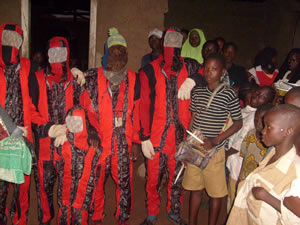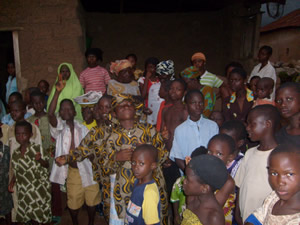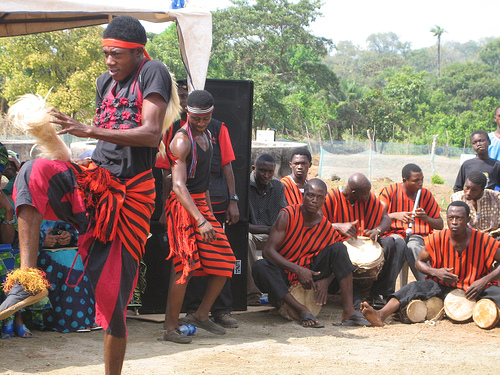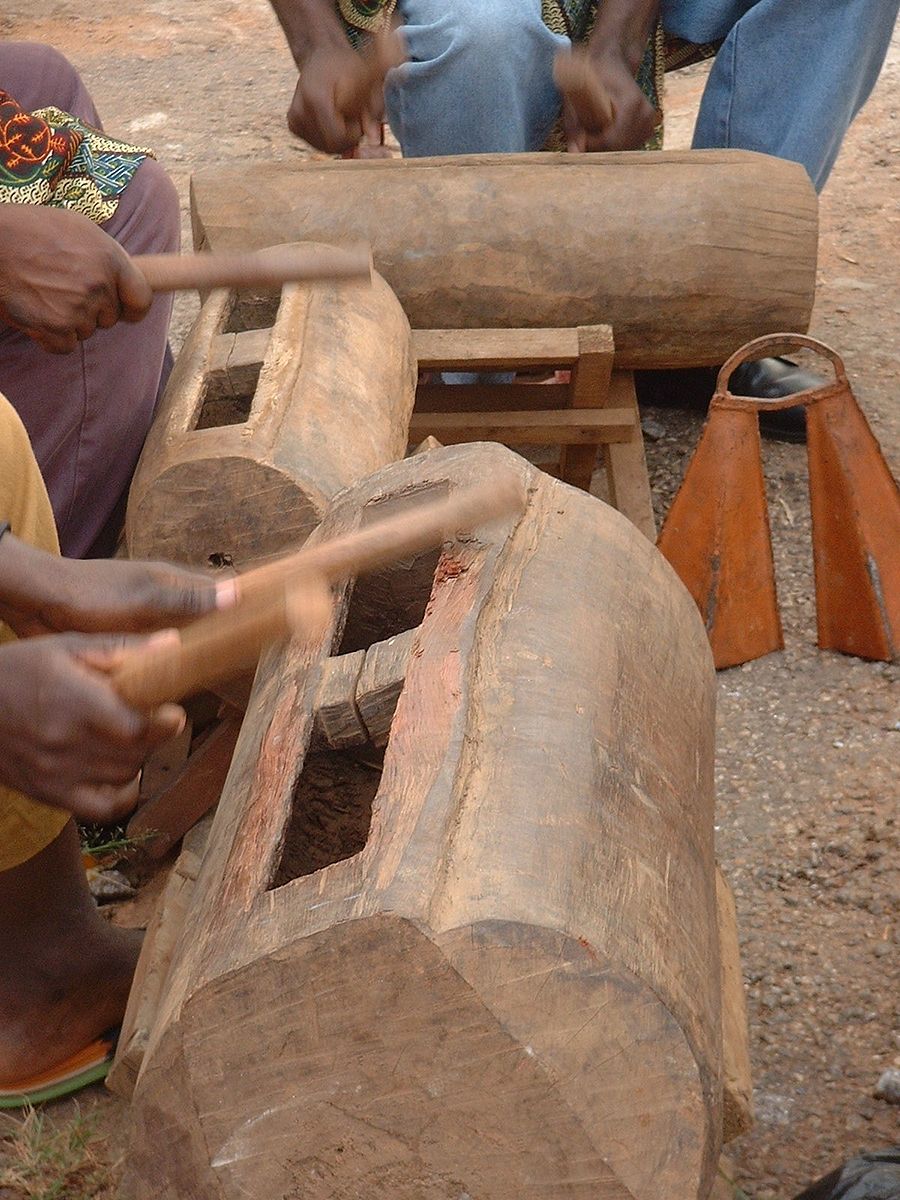
Music in Community Life II
Music and Dance: Eégún Ò̩jè - A Yorùbá Masquerade Performance in Nigeria
The following is a description of a masquerade performance, eégún ò̩je, which I watched in a small village called Ìbà, a rural agricultural village, in Western Nigeria, on July 25, 2007. The people of Ìbà belong to the Yorùbá ethnic group, which, with a population of about thirty million, is one of the three largest ethnic groups in Nigeria. On the day of the performance, I traveled from Òs̩ogbo, the capital city of Òs̩un state, and arrived at Ìbà, at about 6:30PM. I was struck by the sight of many villagers sitting in front of their houses in a relaxed mood, enjoying the cool breeze of the evening. I exchanged greetings with some of them and proceeded to a little mud house roofed with rusty corrugated iron sheets. All the four male dancers that would later perform eégún ò̩je lived in the house. The drummers came from a nearby town, Ìkìrun.
Eégún ò̩jé̩ is a popular Yorùbá song and dance display by a group of masquerades. In many parts of Africa, masquerades are regarded as representations of the spirits of ancestors. Eégún ò̩jé̩ is usually accompanied by bàtá, an ensemble of conically-shaped, double-headed membrane drums, and one of Yorùbá's most ancient instrumental ensembles. Originally context-bound in its association with Yorùbá religious cults, especially that of s̩àngó (the Yorùbá god of thunder and lightning), bàtá music is now also mediated in non-ritual contexts like those of Eégún ò̩jé̩ and jùjú popular music shows.
A bàtá ensemble consists of four drums: ìyáàlù (mother drum) and three supporting drums, omele abo, omele ako and kúdí. Unlike omele ako and kúdí, both of which play repetitive patterns, the omele abo often engages in a dialogue with the ìyáàlù. ìyáàlù is played by a master drummer, whose text-based improvisations are accompanied by the ostinato patterns of the supporting drums. As in most Yorùbá ensembles, the player of the ìyáàlù in this performance was the oldest member of the ensemble.
The performance started when the four masquerades danced from inside the house into the open courtyard in front. As soon as they were sighted, the drummers began to play. I looked around at this point and realized that there was no other person in the vicinity of the performance, apart from me and the performers.
The four masks comprised of three men and a young boy. Each of them was covered from head to toe, wearing colorful attire that was richly decorated with black and white stripes. They all wore a pair of hand gloves, while their faces were covered with a velvet material that had small perforations through which they could see. The leader of the masquerade started the performance with a rather showy acrobatic dance, and was soon followed by other masked dancers who took turns to do a variety of acrobatic movements. These movements involved the use of legs, arms and the torso, and were often sharp and swift, aided by the piercing, staccato sounds of bàtá drums.
Those who were not dancing at any given time sang in call and response format. Vocal rendition functioned rather peripherally, sounding more like an "accompaniment" to the more dominant drumming and dancing. The texts of the songs, many of which engaged in self-praise, often served to punctuate and motivate the dancers into action.
Each solo dance was propelled by an intimate interaction with the master drummer. The dialogue between dancer and drummer was inter-textual in nature, because rhythmic patterns were often answered by dance movements. The dances could be described as a visual and an embodied representation of the bàtá drum language. The more agitated the rhythms were, the more intense the masquerades danced. About twenty minutes into the performance, the dances progressed into more spectacular acrobatic displays, consisting of running, jumping and somersaulting. Such displays are not uncommon in male dances that are associated with bàtá drumming.
After a while, I suddenly realized that a very sizable audience had formed a ring around the performers. The audience was a mixed one, consisting of young boys and girls, elderly men and women. Eégún ò̩jé̩, unlike its more potent counterpart, eégún alágbo (charmed-soaked masquerade) may be watched in performance by any member of the community. Its main role is to entertain. Performances by eégún alágbo, on the other hand, may not be watched by women or children, a taboo that illustrates the ways in which Yorùbá perspectives about gender and age are reflected in music and dance performances.
Many members of the (participating) audience expressed their appreciation of the performance by clapping, shouting and coming into the dance arena to either dance or paste money on the masquerades. Some simply dropped their gifts on the ground within the performance arena. The pasting of money on musicians and dancers as a means of expressing satisfaction with a performance is quite common in many African societies.
The performance ended at about 7:30 pm. The audience, which had now grown into a huge crowd, burst into a loud ovation as the masquerades danced back into the house, while the sounds of the drums stopped, rather reluctantly.
This performance, like the ones earlier described, illustrates certain vital features of African music: the hierarchical conception of instrumental and dance ensembles, typified by the allocation of roles on the basis of age and experience; the multi-media nature of performances, as illustrated in the integrated use of music, dance and costume; the dialogical interaction between dancers and drummers; the noisy rapprochement between audience and performers; and the rather spontaneous approach to the organization of a performance.
No formal invitations were extended to the audience, and yet within a spate of about twenty minutes, a large audience had emerged. It is also interesting that this performance was exclusive to male members of the community, reflecting a general tendency for masquerade and drum performances to exclude women. One notable exception to this is of course the Sande masquerade performance earlier discussed. The fluidity of movement and the dissolution of spatial boundaries as occasioned by the regular "incursions" into the dancing arena by members of the audience also serve to illustrate the intensely interactive nature of African performances. We shall further explore the significance of some of these features later in this chapter.
Music and Dance
Music and dance are inseparable in African performances. Although it is true that many African societies often have separate words for songs, drumming and dance, such words are often interchangeable. For example, the Yorùbá people of Nigeria often use the word ijó (dance) to refer to performances that combine singing, drumming and dance. Similarly, the udje (dance-song) of the Ùrhòbò people of Delta/Edo State of Nigeria provides a classical illustration of the indivisible nature of African music and dance.
![]() IN HIS OWN WORDS:
IN HIS OWN WORDS:
OJAIRE ON UDJE PERFORMANCE (2001)
A unique type of Ùrhòbò dance in which rival quarters or towns perform songs composed from often-exaggerated materials about the other side on an appointed day. Udje songs are thus dance songs sung when udje is being performed…Central to the concept of udje dance songs are the principles of correction and determent through punishment with 'wounding' words.![]()
It is interesting to note that Ojaire describes this traditional performance as "dance-songs." This performance is neither dance nor music, but both. Let us now examine an example to illustrate the interrelations of music and dance.
The Wusa-Poro Performance
This performance of the members of the Poro society of the Vai people of Liberia depicts many of the typical features of African music and dance performances.
The following features are highlighted by these performances:
- The use of a circular performance area in which dancers, musicians and members of a very active audience enact a multi-media performance.
- The use of an instrumental ensemble consisting of two wooden slit-drums and a skin drum.
- The role of a master musician, the kembe, who coordinates the entire ensemble through his performance on a large slit-drum. The kembe is also responsible for training the performers as well as putting together the entire performance.
- The kembe sends musical messages to the dancers to let them know what patterns to dance and when to change from one pattern to another. The kembe uses the slit drum instead of speech to communicate with the dancers.
- The acrobatic nature of these dances is typical of performances by initiates of Poro and Sande societies.





The Vai have professional musicians--both men (manja) and women (kengai)--who receive training in the secret societies and provide music for social activities and events.









